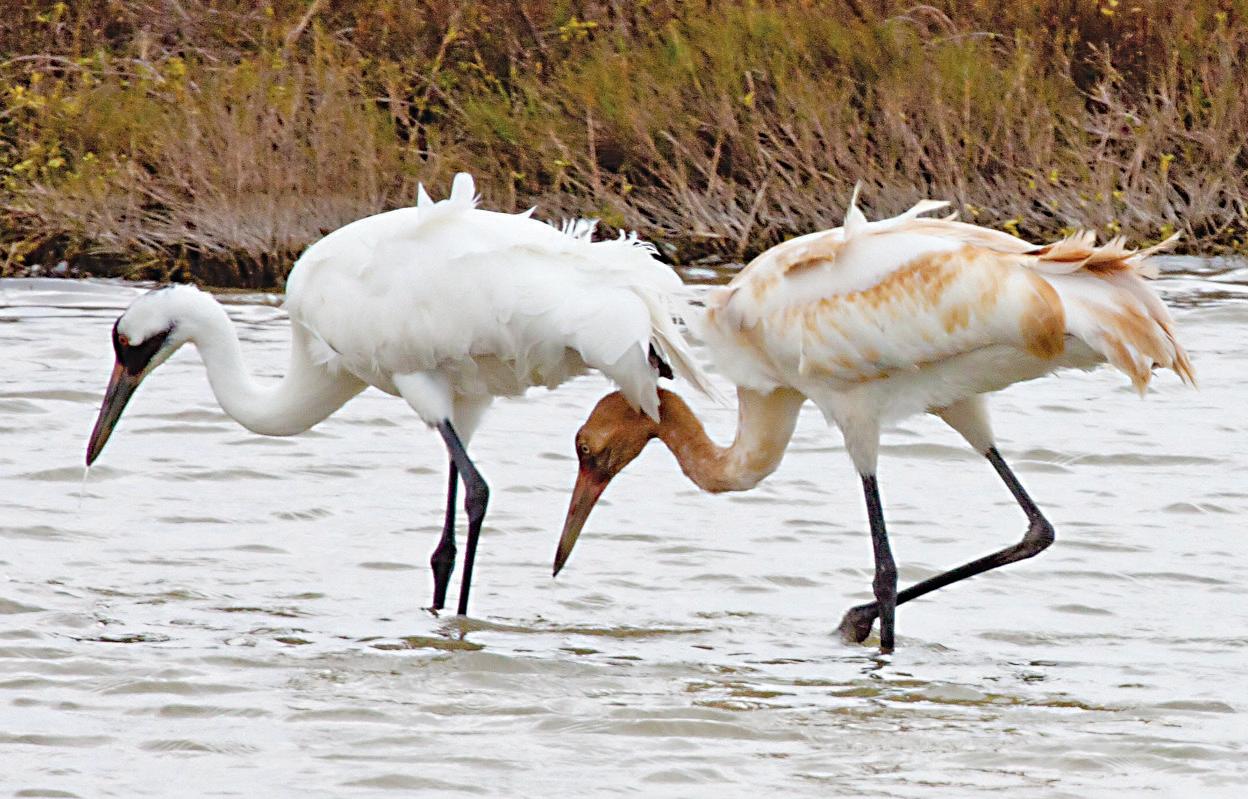
3 minute read
Whooping Crane Migration
WHOOPING CRANE MIGRATION UNDERWAY
WHOOPING CRANES AND OTHER MIGRATING BIRDS RETURN TO THE ROCKPORT-FULTON AREA
Advertisement
Rockport-Fulton, Texas (November 2021) – From November to March more than 500 Whooping Cranes, North America’s tallest bird, call the Aransas National Wildlife Refuge and the surrounding area their winter home. The communities of Rockport and Fulton embrace this phenomenon with boat tours and other viewing opportunities.
Classified as an endangered species in 1967, the wild flock numbered only 15 in the 1940s. The current population is close to 600. A Whooping Crane pair will mate for life. Each year, pairs or families of Whoopers make their way from the marshes of Southern Canada and the Northern U.S. traveling over 2,500 miles to the Texas Gulf Coast.
Nesting in the Aransas National Wildlife Refuge, they can be spotted from time to time as far south as along Goose Island State Park. The marsh in this area offers an excellent habitat for the Whooping Crane, providing Blue Crabs, which is the number one food source for the Whooping Crane, along with an abundance of wolfberries and other food sources. Standing over 5-feet tall, with a 7-foot wingspan, the majestic Whooping Crane is the tallest North American bird.
Land viewing of the birds can be done at the Aransas National Wildlife Refuge, recently named the number one “Best place for birding in the United States” according to USA Today’s 10Best. Located just 30-40 minutes from the Rockport-Fulton area, the Aransas National Wildlife Refuge is a major attraction for the area.
The International Crane Foundation now houses an office in Rockport. The Texas Program is operated by Senior Whooping Crane Scientist, Dr. Liz Smith and her colleagues. According to Dr. Smith, “One of the primary goals of the Texas Program is protecting the coastal habitat for wintering Whooping Cranes, which is critical for the species. There are quite a few other animals who make use of this habitat too, including lots of herons, Sandhill Cranes, wild hogs, and alligators.”
Boat Birding Tours are available from Fulton Harbor. Captain Tommy Moore, who operates the “Skimmer” tour boat at Fulton Harbor, says “We had a late migration this year. The first birds were noted on November 8. It was reported that a record number of Whooping Cranes made a stopover on the Platt River in central Nebraska. Although we have seen 5-6 pairs already this season, it is not uncommon to see 10-15 pairs once the season is in full force. Of the birds we are seeing this season, we are seeing a lot of babies, with varying degrees of adult plumage.”
Other migrating birds have also made their way into the area. Moore states that they have spotted a Bald Eagle which is rare for this area. Oystercatchers are abundant and large American White Pelicans can be seen feeding with Egrets and other species. Rosette Spoonbills can be seen in the marshes and shallow waters, with their right pink plumage is a favorite for sightseers and photographers. Moore adds “We are officially in open season and making trips into the Aransas National Wildlife Refuge. Scheduled trips continue through the end of March. We are excited to see the increased numbers of avid birders coming in this year. We are looking forward to a great season”
The tours are professionally narrated, and binoculars are available for an up-close view. These trips generally last three hours with an average 30-60 species of birds and other animals spotted along the way.
Some area professional fishing guides also offer birding boat tours by appointment. For a list of these operators or for more information on birding, other area attractions, and places to stay in the RockportFulton area, visit www.rockport-fulton.org or call the Rockport-Fulton Chamber of Commerce and Visitors Center at (361) 729-6445.
WHOOPING CRANES



